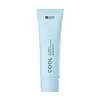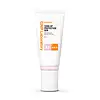What's inside
What's inside
 Key Ingredients
Key Ingredients

 Benefits
Benefits

 Concerns
Concerns

 Ingredients Side-by-side
Ingredients Side-by-side

Water
Skin ConditioningDibutyl Adipate
EmollientPropanediol
SolventDiisopropyl Sebacate
EmollientEthylhexyl Triazone
UV AbsorberTerephthalylidene Dicamphor Sulfonic Acid
UV AbsorberAlcohol Denat.
AntimicrobialNiacinamide
SmoothingPolyglyceryl-3 Distearate
EmulsifyingGlycerin
HumectantTromethamine
BufferingCetearyl Alcohol
Emollient1,2-Hexanediol
Skin ConditioningPentylene Glycol
Skin ConditioningDiethylamino Hydroxybenzoyl Hexyl Benzoate
UV FilterCaprylyl Methicone
Skin ConditioningPolysilicone-15
UV FilterLaminaria Japonica Extract
Skin ProtectingUlmus Davidiana Root Extract
Skin ConditioningOpuntia Ficus-Indica Stem Extract
Skin ConditioningAloe Barbadensis Leaf Extract
EmollientMentha Aquatica Extract
TonicViola Mandshurica Flower Extract
AntioxidantDioscorea Japonica Root Extract
Skin ConditioningBetula Platyphylla Japonica Juice
Skin ConditioningPolymethylsilsesquioxane
Caprylic/Capric/Succinic Triglyceride
EmollientGlyceryl Stearate
EmollientBis-Ethylhexyloxyphenol Methoxyphenyl Triazine
Skin ConditioningPotassium Cetyl Phosphate
EmulsifyingMethylpropanediol
SolventAmmonium Acryloyldimethyltaurate/Vp Copolymer
Ammonium Polyacryloyldimethyl Taurate
Emulsion StabilisingGlyceryl Stearate Citrate
EmollientEthylhexylglycerin
Skin ConditioningAdenosine
Skin ConditioningDisodium EDTA
Sodium Polyacrylate
AbsorbentPolyether-1
N-Butyl Alcohol
PerfumingButylene Glycol
HumectantDipropylene Glycol
HumectantBiosaccharide Gum-1
HumectantTocopherol
AntioxidantParfum
MaskingWater, Dibutyl Adipate, Propanediol, Diisopropyl Sebacate, Ethylhexyl Triazone, Terephthalylidene Dicamphor Sulfonic Acid, Alcohol Denat., Niacinamide, Polyglyceryl-3 Distearate, Glycerin, Tromethamine, Cetearyl Alcohol, 1,2-Hexanediol, Pentylene Glycol, Diethylamino Hydroxybenzoyl Hexyl Benzoate, Caprylyl Methicone, Polysilicone-15, Laminaria Japonica Extract, Ulmus Davidiana Root Extract, Opuntia Ficus-Indica Stem Extract, Aloe Barbadensis Leaf Extract, Mentha Aquatica Extract, Viola Mandshurica Flower Extract, Dioscorea Japonica Root Extract, Betula Platyphylla Japonica Juice, Polymethylsilsesquioxane, Caprylic/Capric/Succinic Triglyceride, Glyceryl Stearate, Bis-Ethylhexyloxyphenol Methoxyphenyl Triazine, Potassium Cetyl Phosphate, Methylpropanediol, Ammonium Acryloyldimethyltaurate/Vp Copolymer, Ammonium Polyacryloyldimethyl Taurate, Glyceryl Stearate Citrate, Ethylhexylglycerin, Adenosine, Disodium EDTA, Sodium Polyacrylate, Polyether-1, N-Butyl Alcohol, Butylene Glycol, Dipropylene Glycol, Biosaccharide Gum-1, Tocopherol, Parfum
Water
Skin ConditioningCyclopentasiloxane
EmollientEthylhexyl Methoxycinnamate
UV AbsorberEthylhexyl Salicylate
UV AbsorberZinc Oxide
Cosmetic ColorantCyclohexasiloxane
EmollientButylene Glycol
HumectantPEG-10 Dimethicone
Skin ConditioningCI 77891
Cosmetic ColorantMethyl Methacrylate Crosspolymer
Dipropylene Glycol
HumectantEthylhexyl Palmitate
EmollientDimethicone/Vinyl Dimethicone Crosspolymer
Skin ConditioningPelargonium Graveolens Flower Oil
MaskingSea Water
HumectantCamellia Sinensis Leaf Extract
AntimicrobialPinus Pinaster Bark Extract
AntioxidantVitis Vinifera Seed Extract
AntimicrobialPortulaca Oleracea Extract
Skin ConditioningPearl Powder
Tourmaline
Caprylyl Methicone
Skin ConditioningCetyl PEG/PPG-10/1 Dimethicone
EmulsifyingDicaprylyl Carbonate
EmollientMagnesium Sulfate
Polymethylsilsesquioxane
Disteardimonium Hectorite
StabilisingIsoamyl P-Methoxycinnamate
UV AbsorberVinyl Dimethicone/Methicone Silsesquioxane Crosspolymer
C30-45 Alkyl Cetearyl Dimethicone Crosspolymer
EmollientAluminum Hydroxide
EmollientStearic Acid
CleansingGlyceryl Caprylate
EmollientDimethicone
EmollientCaprylyl Glycol
EmollientHydroxyapatite
AbrasivePanthenol
Skin ConditioningTriethoxycaprylylsilane
Montmorillonite
AbsorbentBiosaccharide Gum-4
Skin ConditioningThioctic Acid
AntioxidantUbiquinone
Antioxidant1,2-Hexanediol
Skin ConditioningPhenoxyethanol
PreservativeCitronellol
PerfumingGeraniol
PerfumingCitral
PerfumingCI 77492
Cosmetic ColorantCI 77491
Cosmetic ColorantWater, Cyclopentasiloxane, Ethylhexyl Methoxycinnamate, Ethylhexyl Salicylate, Zinc Oxide, Cyclohexasiloxane, Butylene Glycol, PEG-10 Dimethicone, CI 77891, Methyl Methacrylate Crosspolymer, Dipropylene Glycol, Ethylhexyl Palmitate, Dimethicone/Vinyl Dimethicone Crosspolymer, Pelargonium Graveolens Flower Oil, Sea Water, Camellia Sinensis Leaf Extract, Pinus Pinaster Bark Extract, Vitis Vinifera Seed Extract, Portulaca Oleracea Extract, Pearl Powder, Tourmaline, Caprylyl Methicone, Cetyl PEG/PPG-10/1 Dimethicone, Dicaprylyl Carbonate, Magnesium Sulfate, Polymethylsilsesquioxane, Disteardimonium Hectorite, Isoamyl P-Methoxycinnamate, Vinyl Dimethicone/Methicone Silsesquioxane Crosspolymer, C30-45 Alkyl Cetearyl Dimethicone Crosspolymer, Aluminum Hydroxide, Stearic Acid, Glyceryl Caprylate, Dimethicone, Caprylyl Glycol, Hydroxyapatite, Panthenol, Triethoxycaprylylsilane, Montmorillonite, Biosaccharide Gum-4, Thioctic Acid, Ubiquinone, 1,2-Hexanediol, Phenoxyethanol, Citronellol, Geraniol, Citral, CI 77492, CI 77491
 Reviews
Reviews

Ingredients Explained
These ingredients are found in both products.
Ingredients higher up in an ingredient list are typically present in a larger amount.
1,2-Hexanediol is a synthetic liquid and another multi-functional powerhouse.
It is a:
- Humectant, drawing moisture into the skin
- Emollient, helping to soften skin
- Solvent, dispersing and stabilizing formulas
- Preservative booster, enhancing the antimicrobial activity of other preservatives
Butylene Glycol (or BG) is used within cosmetic products for a few different reasons:
Overall, Butylene Glycol is a safe and well-rounded ingredient that works well with other ingredients.
Though this ingredient works well with most skin types, some people with sensitive skin may experience a reaction such as allergic rashes, closed comedones, or itchiness.
Learn more about Butylene GlycolCaprylyl Methicone is a type of silicone.
It helps soften and soothe the skin by creating a thin film on top. This film helps trap moisture, keeping your skin hydrated.
Dipropylene Glycol is a synthetically created humectant, stabilizer, and solvent.
This ingredient helps:
Dipropylene glycol is technically an alcohol, but it belongs to the glycol family (often considered part of the ‘good’ alcohols). This means it is hydrating and gentle on skin unlike drying solvent alcohols like denatured alcohol.
As a masking agent, Dipropylene Glycol can be used to cover the smell of other ingredients. However, it does not have a scent.
Studies show Dipropylene Glycol is considered safe to use in skincare.
Learn more about Dipropylene GlycolPolymethylsilsesquioxane is a silicone used as a film forming agent.
When applied to the skin, this ingredient creates an invisible film on the surface. This film still allows oxygen to pass through, but prevents moisture from escaping. This can help condition and hydrate the skin. It also leaves a silky feel when applied.
Polymethylsilsesquioxane has not been shown to clog pores. It has been deemed safe to use up to 55%, but most cosmetics use much less.
If you have concerns about using this ingredient, we recommend speaking with a professional.
Learn more about PolymethylsilsesquioxaneWater. It's the most common cosmetic ingredient of all. You'll usually see it at the top of ingredient lists, meaning that it makes up the largest part of the product.
So why is it so popular? Water most often acts as a solvent - this means that it helps dissolve other ingredients into the formulation.
You'll also recognize water as that liquid we all need to stay alive. If you see this, drink a glass of water. Stay hydrated!
Learn more about Water